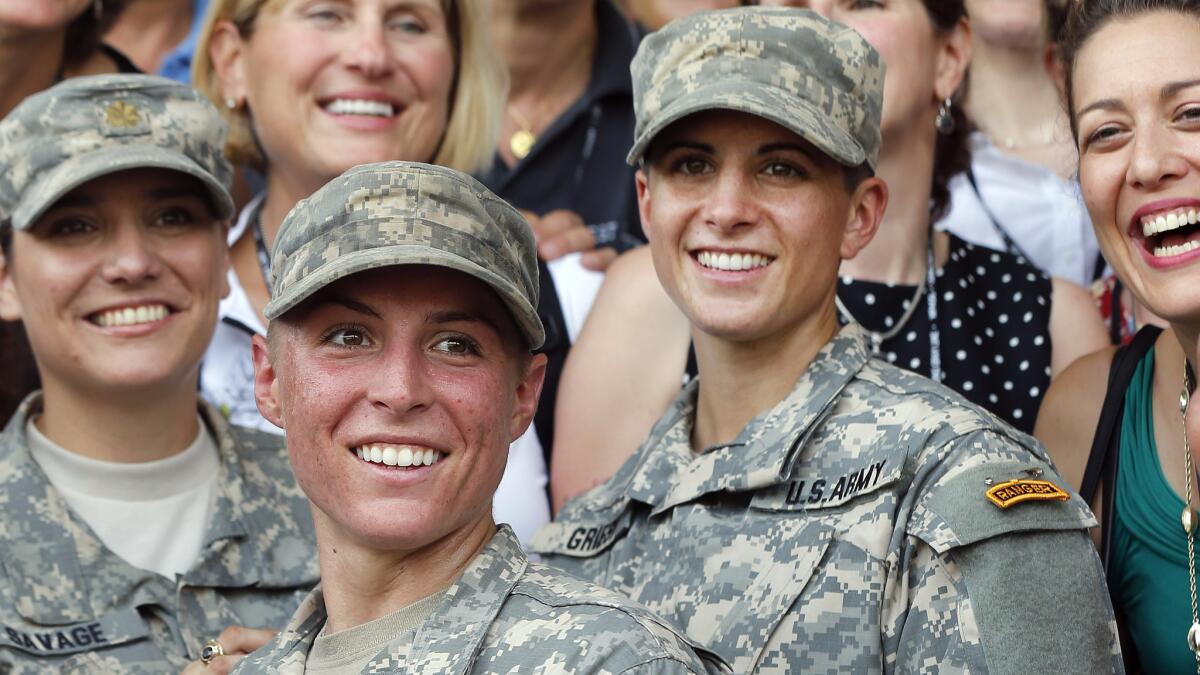Op-Ed: If we really want women in combat, men must do more

- Share via
In December, the Pentagon finally opened all combat jobs to women. Since then only 180 have signed up for the two branches that previously were off-limits — infantry and armor. To illustrate how few that is, the Army’s active-duty infantry is made up of more than 60,000 soldiers. The number of female troops volunteering for the newly opened “close combat” jobs is a pittance.
The Army’s highest ranking non-commissioned officer recently sent an email to every soldier in the ranks, asking women to step up, but a single email won’t do it.
We can’t merely open the door to women, we need to help them walk through it with recruitment campaigns to encourage the most qualified to apply, specific messages that explain why they are needed on the battlefield, and special programs to help them prepare physically. Female mentors are important, but experience and common sense indicate that male soldiers and senior leaders have to engage women, face-to-face, if the military is going to be fully integrated.
Of course, women have served with men on the battlefield for a long time. Many have fought bravely in Iraq and Afghanistan. But until the Pentagon’s policy change, female troops didn’t have the opportunity to be trained, equipped and deployed specifically to fight with men in units designed to engage in front-line close combat.
In Afghanistan ... cultural and religious sensitivities prohibit male troops from questioning, searching or even interacting with half of the local population.
In 2010, women were offered the chance to be “attached” to the elite special operations forces, in support roles. Special forces commanders decided they needed women to work with their units in Afghanistan because cultural and religious sensitivities prohibit male troops from questioning, searching or even interacting with half of the local population — Afghan women.
Stories of how active-duty female soldiers learned about the Special Forces “Cultural Support Teams” are detailed in the book “Ashley’s War.” Recruiters were assigned to seek out the best qualified women. Fliers were plastered on the walls of gyms and malls at all the major bases. Emailed notices invited female troops to be “a part of history,” to “join the elite Special Forces.” More telling, many who signed up were specifically persuaded by male superiors, family members and friends who recognized their abilities and urged them to apply.
Last year, three female officers made headlines when they successfully completed a “gender integrated assessment” in the Army’s most rigorous combat leadership course, Ranger School. (All male officers joining the infantry must attend the course; fewer than half pass.) One of the graduates, Maj. Lisa Jaster, told interviewers that she hadn’t even considered enrolling in the course until her husband and her (male) command sergeant major insisted she try.
All close combat units have high entry standards. Infantry troops, for example, have to be able to carry heavy weights on their backs over long distances. The physical and mental demands of close combat are extreme. The job is not for the average soldier. A year-long Marine Corps study found that all-male infantry units were faster, more lethal and able to evacuate wounded soldiers in less time than mixed-gender test groups. Simply put, the study found that the average man was stronger than the average woman.
My experience training women confirms this, and what I tell them about the infantry is that average women shouldn’t apply but the above average should: those who are strong both physically and mentally and those who want to lead infantry soldiers in combat. Because it’s crucial to maintain the same physical standards for men and women in close combat assignments, the military should put into place long-term physical training programs to help women develop the abilities to meet those requirements.
A “We Want You” campaign directed at women isn’t merely a frivolous, politically correct exercise. The United States is fighting in cultural settings far different from our own. Having female troops in every combat role is crucial for intelligence gathering and interacting with local populations. Besides, men haven’t cornered the market in decision-making under stress. The complexities and chaos of combat environments demand diversity of thought, skills and capabilities.
The military must identify the best female candidates in high schools, colleges and military academies, sell them on the importance of their presence in the newly opened combat roles and get them proper training. Military men — husbands, bosses, coaches and friends — can help on all those counts.
If men don’t step up, we risk that so few women will apply for close combat jobs that their value will be little felt on the battlefield, or worse, that the women who are accepted will only just make the cut. That could confirm the biases of those who think that women never should have been on the battlefield in the first place.
Army Maj. John Spencer is an infantry soldier with 23 years’ experience, including two combat tours. He is a scholar with the Modern War Institute at the U.S. Military Academy in West Point.
Follow the Opinion section on Twitter @latimesopinion and Facebook
MORE OP-EDS:
Fathers of daughters may feel insulted, but fathers of sons can fix the problem
Pity America’s men: From football to politics, they (think they) are under attack
It takes a village to raise a misogynistic monster like Donald Trump
More to Read
A cure for the common opinion
Get thought-provoking perspectives with our weekly newsletter.
You may occasionally receive promotional content from the Los Angeles Times.










